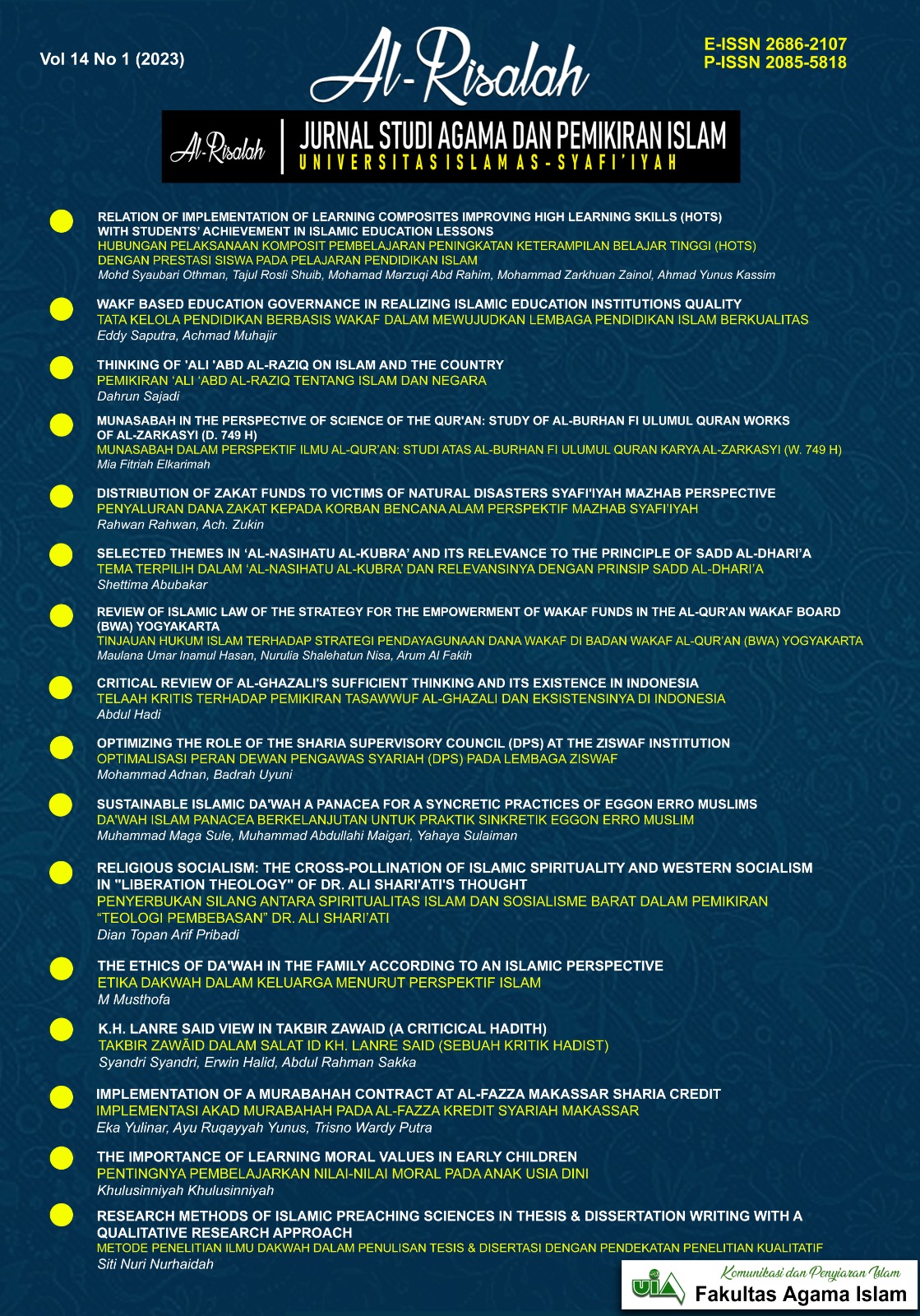RELIGIOUS SOCIALISM: THE CROSS-POLLINATION OF ISLAMIC SPIRITUALITY AND WESTERN SOCIALISM IN "LIBERATION THEOLOGY" OF DR. ALI SHARI'ATI'S THOUGHT
PENYERBUKAN SILANG ANTARA SPIRITUALITAS ISLAM DAN SOSIALISME BARAT DALAM PEMIKIRAN “TEOLOGI PEMBEBASAN” DR. ALI SHARI’ATI
Abstract
At the beginning of the XIX century, the world's people entered a new phase of life. But this era gave birth to a more complex and "expensive" social face. The industry is a main form that inundates the community's yard. The spirit of individualism creates a quasi-binary opposition. Strong-weak, rich-poor. One by one, various ideologies emerged as the antithesis of Capitalism, from socialism-communism to democratic socialism. Then came the new idea of the renaissance of religious socialism. Religious socialism has been born since the prophets were sent as caliphs on earth. Learning from the history of the struggle of the saints who sought to liberate the oppressed, religious socialism tries to pave the way for an alternative solution, the fourth path. Ali Shari'ati first used this paradigm when he strongly criticized the two great ideological empires, socialism and capitalism. According to Shari'ati, socialism in Islam can be functionalized into a central view of life philosophy of bringing people to make social changes. In terms of international politics, Ali Shari'ati's Religious Socialism was more closely associated with the political constructs that were taking place in Iran at the time. By using a qualitative approach and making his scattered works and thoughts and expert analysis related to his thoughts the sources in this article.
Di awal abad ke-19, masyarakat dunia memasuki babak baru kehidupan. Namun era ini melahirkan wajah sosial yang lebih kompleks dan “mahal”. Industri merupakan bentuk utama yang menggenangi pekarangan masyarakat. Semangat individualisme menciptakan kuasi-biner oposisi. Kuat-lemah, kaya-miskin. Satu persatu berbagai ideologi muncul sebagai antitesis Kapitalisme, mulai dari sosialisme-komunisme hingga sosialisme demokratik. Kemudian muncul ide baru tentang renaisans sosialisme religius. Sosialisme keagamaan telah lahir sejak para nabi diutus sebagai khalifah di muka bumi. Belajar dari sejarah perjuangan para wali yang berusaha membebaskan kaum tertindas, sosialisme religius mencoba membuka jalan bagi solusi alternatif, jalan keempat. Ali Syari'ati pertama kali menggunakan paradigma ini ketika mengkritik keras dua imperium ideologi besar, sosialisme dan kapitalisme. Menurut Syari'ati, sosialisme dalam Islam dapat difungsikan menjadi pandangan sentral falsafah hidup yang membawa manusia melakukan perubahan sosial. Dalam politik internasional, Sosialisme Keagamaan Ali Syari'ati lebih erat kaitannya dengan konstruksi politik yang sedang berlangsung di Iran saat itu. Dengan menggunakan pendekatan kualitatif dan menjadikan karaya-karaya serta pemikirannya yang tersebar dan Analisa para ahli terkait pemikirannya menjadi sumber dalam artikel ini.
Copyright (c) 2023 Al-Risalah : Jurnal Studi Agama dan Pemikiran Islam

This work is licensed under a Creative Commons Attribution 4.0 International License.
This work is licensed under a Lisensi Creative Commons Atribusi 4.0 Internasional.
Authors who publish with this journal agree to the following terms:
- Authors retain copyright and grant the journal right of first publication with the work simultaneously licensed under a Creative Commons Attribution License that allows others to share the work with an acknowledgement of the work's authorship and initial publication in this journal.
- Authors are able to enter into separate, additional contractual arrangements for the non-exclusive distribution of the journal's published version of the work (e.g., post it to an institutional repository or publish it in a book), with an acknowledgement of its initial publication in this journal.
- Authors are permitted and encouraged to post their work online (e.g., in institutional repositories or on their website) prior to and during the submission process, as it can lead to productive exchanges, as well as earlier and greater citation of published work (See The Effect of Open Access).















